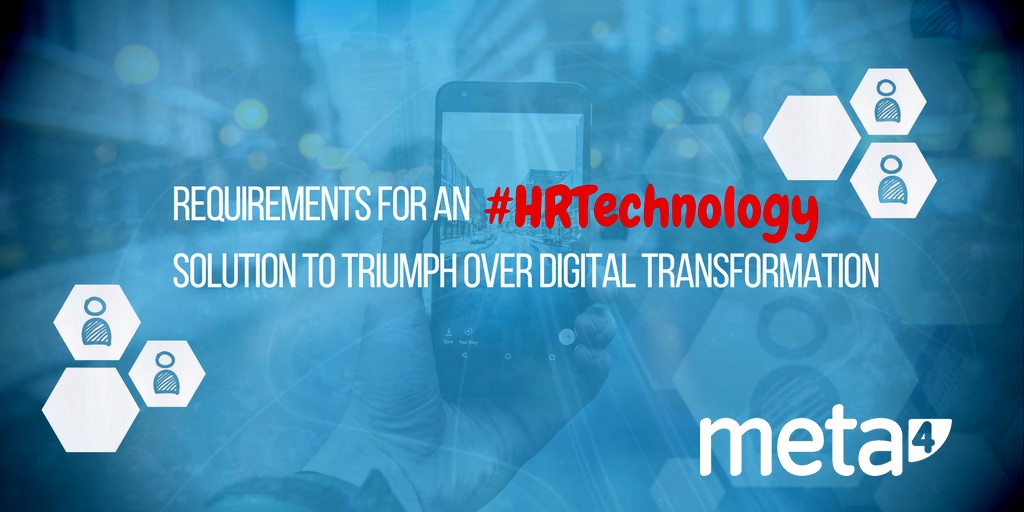Author: Enrique Sala Pascual
Evidently, with the growing pace of automation and change in the digital era, success in organizations will increasingly depend on human talent, creativity and innovation. Only those organizations that have the right HR technology can manage talent efficiently. We need technology tools to identify where talent is and what the patterns are. Moreover, we rely on HR technology to handle processes and routine administrative tasks that were previously done manually.
From our point of view, there are 10 key characteristics that an HR technology solution should embody in order to help the HR professionals with the challenge of talent digitization: Enable the company and their activity to be organized by the demands from new digital business models.
1. Enable the company and their activity to be organized by the demands from new digital business models. An HR technology solution should enable the creation and coexistence of various existing organizational structures, working by projects, n-dimensional dependencies (double unit, triple units). These are critical for the company’s business strategy in the digital era.
2. Promote the digitalization of the HR functions. Technology solutions must serve as a repository for all the information on the employee lifecycle used in the company (organization, training and salary data, etc.). Likewise, they must also enable all or most HR processes, to be developed digitally at the internal (HR department) and external levels (employees, managers, work units, etc.), in the same way as people live and work in a digital environment.
3. Evolve in pace with the transformation of the digital ecosystem. Enable the company to keep aligned with the needs of their business model as well as the needs of their partners, suppliers, shareholders, etc., and thus contribute to its success at all times.
4. Maintain digital experience among users. This is not about digitalizing things that were done manually, but rather about delivering a true digital experience that is also attractive and simple, bringing value to the user. Firstly, for whoever requests the service (end user), and secondly, for whoever delivers the service/exploits data.
5. Transform data into knowledge. This isn’t about making a large volume of data available, but rather about transforming them meaningfully into useful information that we can fully exploit for a given knowledge-related goal and for decision making. Other than helping us to ask the right questions, the tool must offer appropriate solutions. Even though to achieve this it is necessary to set down the rules of the game, the definition will allow us to modify and evolve them as often as needed. Besides, this allows us to forecast events and situations that are likely to be subject to modifications, improvements or be dropped.
6. Improve the internal and external HR image. External, because an HR technology solution will allow us to manage our sourcing for candidates, customers and stakeholders. Internal, because we will be able to manage our teams and people, and ultimately our know-how. Using these tools will allow us to obtain information in order to improve our recruitment processes, define jobs, analyze the internal and external environment, evaluate more effectively and fairly, make decisions about our employees’ future, or define their development plans—with accessible and up-to-date information anytime anywhere. In short, an HR technology solution should deliver our employees and partners the perception of a transparent work environment and also convey the organization’s goals and how it functions.
7. Ability for self-criticism and rigor in the digital environment. Starting with what we know and what we don’t know. What we have and what we don’t have. When we need it, and when we can have it. And how much it will cost. The answers to all these questions lean on the ability to identify the digital skills we need, have, or lack; the ones that can be or not be developed, and other ones which we will have to look for outside our organization. This is not about whether people have technical knowledge (measurable/certifiable) or experience. More often than not it’s about whether they have digital attitudes/behaviors. That’s why it’s critical that our models and tool for assessment, definition, recruitment, interviews can determine the level or threshold at which these skills are present and to what extent.
8. Principle of action and reaction. In the digital world, things happen fast and any action we do has a response, hopefully, an immediate one (even if it is just to say “your operation is being processed”). In a tool for managing talent in the digital world, this means that a question from an employee or manager requires a response, an assessment requires a score along with an action plan, and a profile definition receives candidates who fit or don’t fit into the vacant post. In short, a technology solution must always provide a specific response to a need.
9. SMACT: The acronym for Social Networks, Mobility, Analytics or Big Data, Cloud and Things – as in the Internet of Things. Embodying all these ideas must be well developed and integrated into the HR technology solution. Likewise, these must be mirrored in the benefits for the organization and their employees in terms of digital transformation
10. Agility: the notion of immediacy in the digital context requires acting swiftly and simply. The HR function must adapt to the dizzying pace of action their organizations demand and become a facilitator rather than a burden so that the organization’s business goals can be achieved.
{{cta(‘6a313d20-b8f9-4fab-90c5-8bcc6f360cb3’)}}






